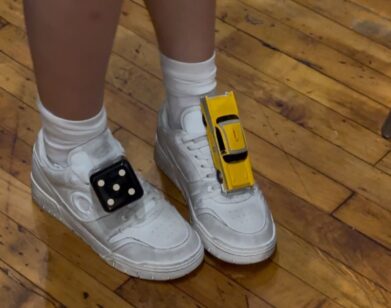Shelley FOX & Philip Aarons

ABOVE: COLLECTORS SHELLEY FOX AND PHILIP AARONS AT THEIR HOME IN EAST HAMPTON, NEW YORK, OCTOBER 2014. ALL CLOTHING: SHELLEY AND PHILIP’S OWN.
What was the first artwork that you collected?
We were in our twenties and planning our wedding. We loved the work of the artist Lawrence Kupferman, who was a close friend of Phil’s parents. Kupferman is not really remembered today, but he was the head of painting at Massachusetts College of Art and Design, and his work is in the permanent collection of MoMA. The story is told that Jackson Pollock got the idea of pouring paint from Kupferman when both were summering in Provincetown. Whether that is true or apocryphal, Kupferman made lovely paintings. And we boldly requested to receive one as a wedding gift. He gave us a beautiful watercolor on paper, which we still own today.
What are some of the most challenging pieces you’ve brought into your lives, and how did you have to change the space to accommodate them?
Probably the most challenging install was our fountain by Klaus Weber, which is comprised of seven large-scale figures, one of the artist himself vomiting, and the others being representations of his friends crying, spitting, sweating from an armpit … From the moment we saw the work at the Herald St gallery in London in 2006, we imagined it installed on the terrace of a house we have in Connecticut. Getting it there, though, was a pretty complicated matter. Actually our son Zach took on the project and corresponded with the artist to design how the figures would be arranged. It was necessary to install a pool under the terrace pavers for the fountain water.
Are there any works that require special maintenance?
Although we cover the Weber fountain figures in winter to protect them, wasps often nest in their orifices and need to be removed in the spring. And it seems we are always asking Simon Fujiwara to give us extra blown eggs to replace the ones that inevitably get broken in his sculpture that we have in our living room. Electronic art is also rather high maintenance. We need someone to fix a Jonathan Monk laser projection right now! We often say that collecting art is a high-maintenance pursuit.
How important is it to know the artist when collecting her or his work?
It’s really not important, but it can be very interesting. We do like to meet and talk with artists, and several have become close friends. But we also own work by artists we’ve only met briefly, or not at all.
You’ve supported so many young artists at the beginning of their careers. Are there any young artists you are excited about right now?
We have been very fortunate to meet quite a few young artists at the beginning of their careers, and many remain dear friends. But we think it’s important not to fetishize youth, and we continue to buy work by artists of all ages.
The role of the collector has become so influential in the art world. In fact, some say it’s superseded the power of curators or gallerists. Do you think there is any particular responsibility a collector has?
All are vitally important both to the art world and the art market. Sometimes collectors will bring an artist to prominence through market activity, which is not necessarily a bad thing. Curators obviously can provide exposure for artists whose work is not readily sold. We can’t speak for others, but as collectors we try to be supporters and not just consumers of contemporary art by helping to fund museum shows or artist publications or production expenses in certain situations.
You tend to collect as a team. Are there any aesthetic differences that arise between you when considering a work?
We both have pretty eclectic taste, yet it is also quite similar. We like to support each other’s interests and enthusiasms. Occasionally, we do buy things on our own without consulting the other person, but not if it’s a major purchase-either in size or price. Our discussions are pretty spontaneous. Art is a major topic for us, but now it comes second to our grandson.
How often do you rotate your collection?
We have an unfortunate tendency to add things rather than to rehang. When the home starts to look like a flea market, we relent and send some things to storage.
Is there anything that frustrates you about the art world?
Sometimes we think there could be more humanity. Phil thinks there should be fewer galas and dinners, but Shelley disagrees on that.
Between the two of you, you’re on the boards of many institutions-the New Museum, MoMA PS1, Creative Time. Are there any others dear to your heart right now?
Right now our main focus is on Printed Matter. We’re very excited to be helping out as the organization prepares to move to a fantastic new space [in Chelsea].
What do you imagine being the fate of your collection in 100 years?
Our current activities are not geared to posterity.






